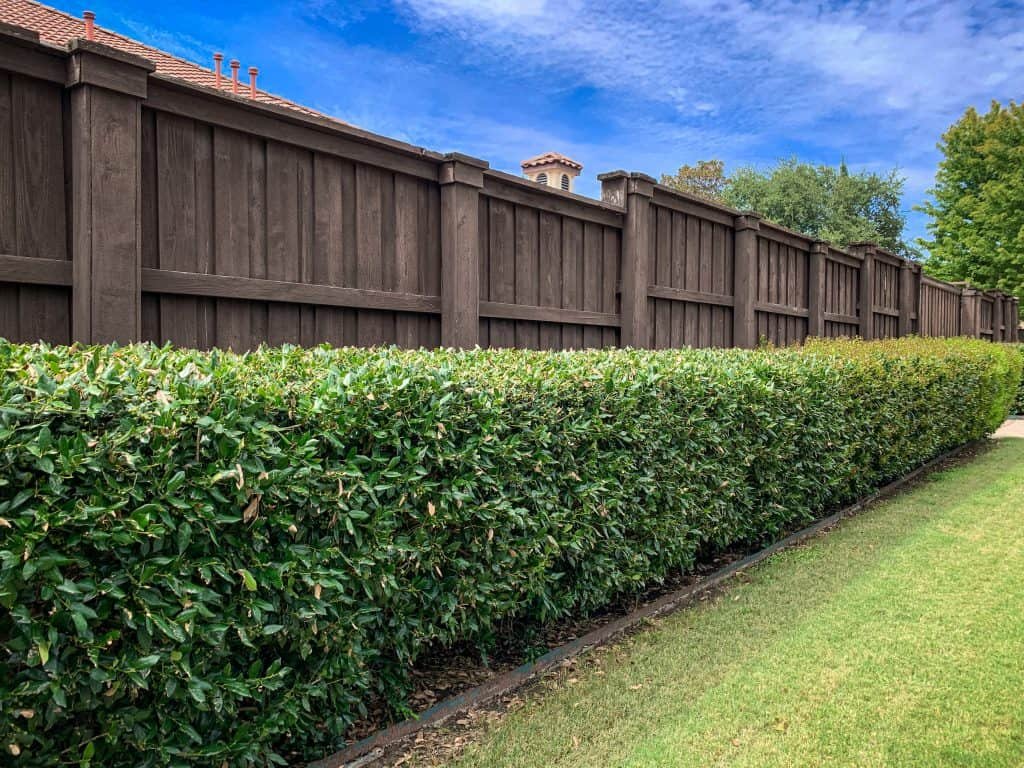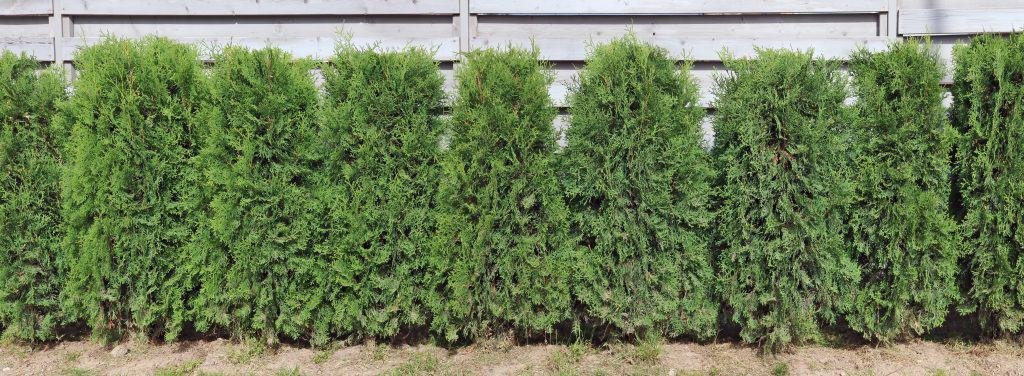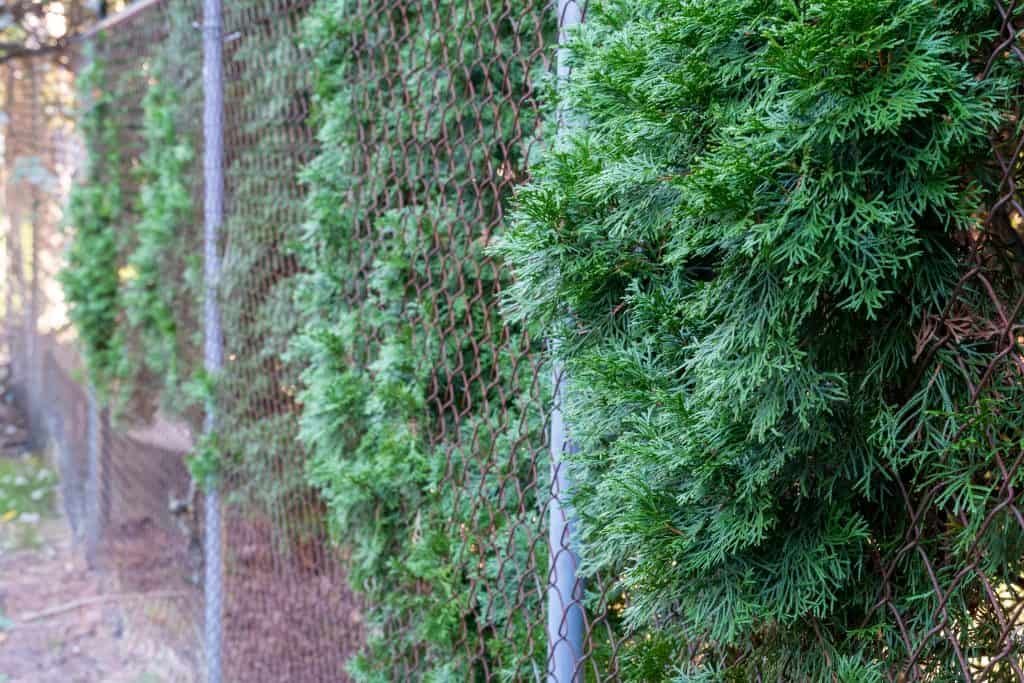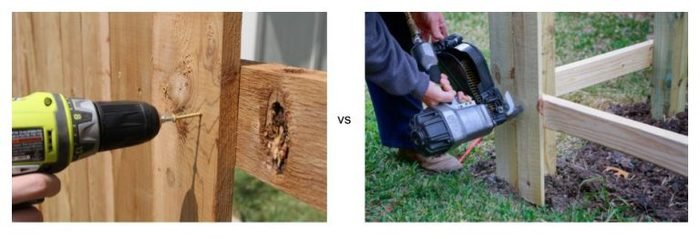How Close to a Fence Can I Plant a Hedge?
If you ever find that your fence is no longer providing the privacy you need, adding a hedge is a great idea. But in order to complete this planting project successfully, you need to know how close to your fence you can plant your hedge.
The spacing you need between your fence and your new hedge depends on the species of plant you are planting. You will need to anticipate the mature size of that species. Use that size as a reference when you layout your hedge along the fence.
Planting your hedge too close to a fence can quickly create an overgrown appearance. To avoid this, follow our advice below on how to properly plant a hedge next to your fence.
Table of Contents
How to Plant a Hedge Along a Fence

The difficulty in planting a hedge lies more in the physical labor than the planning. But there are still some guidelines you need to keep in mind. By following a few simple steps, you can ensure that you plant your hedge correctly.
Choose Your Species
There are many popular plant species commonly featured in privacy hedges. In general, these species tend to be evergreens. The reason behind this is that evergreens hold their foliage all year. That means you will still have privacy, even in the winter months. They’re also a great way to hide an unattractive fence. Here are a few of the best hedge plant options:
- Yew
- Boxwood
- Arborvitae
There are plenty more options for you to explore. Regardless of the species you choose, there are a few traits you need to know. They are:
- Mature height
- Growth rate
- Ideal growing conditions
The first two items will dictate both spacing and how soon your hedge will fill in. The plant’s individual growing requirements will determine if your hedge will survive in your yard in the first place.
Ensure Proper Spacing
Here is how to tell how far from your fence you should plant your hedge:
- Find the plant species’ mature width (also referred to as “spread”)
- Divide that number in half
- Use that number as the distance between your fence and the center of your planting hole
Remember that you can trim many hedge plants to be much smaller than their listed mature dimensions. For example, arborvitaes have a listed mature spread of 10-15 feet. In reality, many arborvitae hedges are thinner as a result of trimming. You should also consider whether you still want space between the fence and your hedge once your hedge is mature. If so, add a foot or two to the dimension you calculated.
Spacing for a hedge does not only relate to the fence. You also need to pay close attention to how close the individual plants in your hedge are from one another. When in doubt, use the mature plant width as the distance between the center points of each planning hole.
Dig a Good Planting Hole
Spacing dimensions are not the only important spatial consideration when planting a hedge. The planting hole you dig for each plant should follow specific measurement guidelines as well.
When you purchase a plant, the roots are often contained in a clump of soil called a root ball. Look closely at the height and width of the root ball. When you dig your planting hole, your hole should be:
- About as deep as the root ball is tall
- Twice as wide as the root ball
These dimensions are important because they give the plant space to spread its roots. Also, by matching the height of the root ball, it is less likely that you will cover the root flare with soil. Covering the root flare with soil can be detrimental to the plant’s long-term health.
Remain Patient

It takes time for juvenile plants to reach their full mature size. That means that you will need to be patient after planting as your hedge takes shape. Even if you purchase relatively large plants, it will likely take a few seasons for all the gaps in your hedge to fill in.
Maintaining Your Hedge
After you have planted your hedge, the best approach you can take is to immediately begin a quality maintenance routine. A typical plant care routine consists of these three main tasks:
- Pruning
- Watering
- Fertilizing
Proper care is the best way to ensure that your hedge fills in as quickly as possible. Read on the learn a bit more about these three gardening chores.
Pruning
Many people are intimidated by the prospect of pruning their plants. Often, they are fearful that they will kill the plant by accident. However, as long as you are deliberate in the cuts you make, your pruning will help rather than hurt your plants.
There are many ways to approach pruning. That is because pruning can serve both functional and aesthetic purposes. To keep matters simple, here is a straightforward approach to pruning. If nothing else, when you prune, be sure to remove any branch that is:
- Broken
- Clearly dead
- Crossing another branch
Removing these branches helps encourage the plant to allocate its energy towards developing a strong and attractive growth habit.
Watering
As most know, watering is an essential aspect of plant care. When it comes to planting a hedge, your watering routine will depend on the type of plant you have.
In general, you need to provide more water just after planting. This helps the plant overcome the shock of the planting process. The same is true during dry spells.
After a plant has established itself in its new location, you can usually reduce the water you give it. The establishment period can take a few seasons.
Fertilization
Fertilization stimulates plant growth. So, if you want your hedge to fill in as quickly as possible, you will want to use fertilizer.
Different plant species need different varieties of fertilizer. Again, you will need to check the specific growing requirements of your plant.
It is often best to fertilize your plant at the beginning of the growing season. This sets your plant on a path towards vigorous growth throughout the year.
What Happens When A Hedge is Too Close to a Fence?

No one would intentionally plant a hedge too close to a fence. But it happens by accident all the time. When a fence and a hedge are too close, some difficult issues can arise.
First, as the plant continues to grow, it will begin to engulf the fence. Branches can spread through, over, and around the fence. Without pruning, this can lead to a very unkempt appearance. While you may achieve the privacy you want, you do so at the expense of your property’s appearance.
Secondly, an unmanaged hedge can ruin a fence in extreme scenarios. This is especially true for chain-link fences. When unmanaged, the trunks and branches of a hedge can become intertwined in the fence. As these parts of the plant harden, it can become nearly impossible to remove both the plant or the fence.
But don’t worry, these cases only happen through poor planning and a lack of maintenance. As long as you avoid both, you should have no issue.
Conclusion
Planting a hedge next to a fence is a great way to screen a neighboring property. But without proper planning, your hedge planting project can easily go awry. Just remember that the species of plant you choose is the main factor that determines the space you need between your fence and your hedge. By respecting the needs of your plant, you can create a beautiful hedge that will thrive for years to come.





